An Assembly Accuracy Analysis Method for Weak Rigid Components
Abstract
1. Introduction
2. Literature Review
- The development of assembly deviation representation models.
- The computational methods for deviation propagation and accumulation analysis.
2.1. Research on Assembly Deviation Modeling Methods
2.2. Research on Deviation Propagation and Accumulation Calculation
- (1)
- Rigid–flexible coupling deviation modeling for WRCs requires further research.
- (2)
- Deviation propagation and accumulation in WRCs demand deeper investigation.
3. General Outline of WRC Assembly Accuracy Analysis
4. Equivalent Analysis of Assembly Deformation Deviation Sources Based on Fit Changes
- (1)
- Impact of assembly deformation on part size
- (2)
- The influence of assembly deformation on the assembly position of parts
5. Construction of Rigid–Flexible Coupling Multi-Dimensional Vector Ring Model Based on Assembly Constraints
5.1. Rigid Component Assembly Deviation Transfer Model and Vector Ring Equation Construction
5.1.1. The Principles of Deviation Transfer Path Construction Between Parts
- (1)
- The deviation enters the interior of the part from the assembly connection. In the deviation transfer model shown in Figure 5, the deviation enters part i through the connection point J1 (part i − 1, part i) of the line–surface fit, and enters part i + 1 through the connection point J2 (part i, part i + 1) of the arc–arc fit.
- (2)
- Inside the part, the deviation reaches the DRF along the direction of the DFC. For example, inside part i as shown in Figure 5, the deviation reaches DRF1 along DFC11; inside part i + 1, the deviation reaches DRF2 along DFC21.
- (3)
- Inside the part, the deviation reaches another assembly connection along the direction of the second DFC. For example, inside part i as shown in Figure 5, the deviation reaches the assembly connection J2 (part i, part i + 1) along DFC12; inside part i + 1, the deviation reaches the assembly connection J3 (part i + 1, part i + 2) along DFC22.
- (4)
- The deviation exits the part from the assembly joint and enters the adjacent part.
5.1.2. Deviation Transfer Vector Loop Construction in Assembly Process
5.1.3. Deviation Transfer Vector Equation Construction
5.2. Assembly Deviation Transfer Model of WRCs with Rigid–Flexible Coupling and Construction of Vector Loop Equation
6. Assembly Accuracy Analysis Algorithm Process Design Based on Monte Carlo Algorithm
- Step 1: Define the deviation sample size n. A larger sample size increases the accuracy of assembly accuracy simulations. However, excessively large samples proportionally increase the computational time and cost. Since product assembly qualification rates do not require 100% perfection, a statistically representative Gaussian distribution can be approximated within limited computational time. Thus, this study sets the simulation frequency to 5000.
- Step 2: Extract and define tolerance information. Extract the part design tolerance in the design model and the assembly tolerance in the process model. Define the equivalent deviation information, tooling positioning tolerance and other information in the assembly accuracy information model as input information for the assembly accuracy simulation.
- Step 3: Generate random deviation. By using a random number generator, the deviation values in the tolerance domain are randomly extracted from the various tolerance information input in step 2 to generate random deviations.
- Step 4: Calculate the predicted value of assembly accuracy. Solve the assembly accuracy analysis function and calculate the assembly accuracy analysis value. If the sample quantity requirement is met, go to step 5; otherwise, go to step 1 to redefine the sample quantity n.
- Step 5: Statistical analysis of assembly accuracy prediction values. Perform statistical analysis on the calculated values of multiple samples, compare them with the predetermined assembly accuracy requirements (design requirements), and provide the predicted evaluation value and the average value and qualification rate of the calculation analysis function.
7. Case Study and Discussion
8. Conclusions
Author Contributions
Funding
Data Availability Statement
Conflicts of Interest
Correction Statement
References
- Maltauro, M.; Passarotto, G.; Concheri, G.; Meneghello, R. Bridging the gap between design and manufacturing specifications for non-rigid parts using the influence coefficient method. Int. J. Adv. Manuf. Technol. 2023, 127, 579–597. [Google Scholar] [CrossRef]
- Atik, H.; Chahbouni, M.; Amegouz, D.; Boutahari, S. Optimization tolerancing of surface in flexible parts and assembly: Influence Coefficient Method with shape defects. Int. J. Eng. Technol. 2018, 7, 90. [Google Scholar] [CrossRef]
- Polini, W.; Corrado, A. Methods of influence coefficients to evaluate stress and deviation distribution of flexible assemblies—A review. Int. J. Adv. Manuf. Technol. 2020, 107, 2901–2915. [Google Scholar] [CrossRef]
- Hillyard, R.C.; Braid, I.C. Characterizing non-ideal shapes in terms of dimensions and tolerances. Acm Siggraph Comput. Graph. 1978, 12, 234–238. [Google Scholar] [CrossRef]
- Zhang, B.C. Geometric Modeling of Dimensioning and Tolerancing. Ph.D. Thesis, Arizona State University, Tempe, AZ, USA, 1992. [Google Scholar]
- Shen, T.H.; Lu, C. An assembly accuracy analysis approach of mechanical assembly involving parallel and serial connections considering form defects and local surface deformations. Precis. Eng. 2024, 88, 44–64. [Google Scholar] [CrossRef]
- Zhao, B.; Wang, Y.; Sun, Q.; Zhang, Y.; Liang, X.; Liu, X. Monomer model: An integrated characterization method of geometrical deviations for assembly accuracy analysis. Assem. Autom. 2021, 41, 514–523. [Google Scholar] [CrossRef]
- Cui, L.; Sun, M.; Cao, Y.; Zhao, Q.J.; Zeng, W.-H.; Guo, S.-R. A novel tolerance geometric method based on machine learning. J. Intell. Manuf. 2021, 32, 799–821. [Google Scholar] [CrossRef]
- Laifa, M.; Sai, W.B.; Hbaieb, M. Evaluation of machining process by integrating 3D manufacturing dispersions, functional constraints, and the concept of small displacement torsors. Int. J. Adv. Manuf. Technol. 2014, 71, 1327–1336. [Google Scholar] [CrossRef]
- Jin, S.; Chen, H.; Li, Z.; Lai, X. A small displacement torsor model for 3D tolerance analysis of conical structures. Proc. Inst. Mech. Eng. Part C J. Mech. Eng. Sci. 2015, 229, 2514–2523. [Google Scholar] [CrossRef]
- Wu, Y.G. Tolerance mathematical model based on the variation of control points of geometric elemen. J. Mech. Eng. 2013, 5, 138. [Google Scholar] [CrossRef]
- Guo, F.; Bao, Q.; Liu, J.; Sha, X. Assembly quality control technologies in forced clam and compensation processes for large and integrated aeronautical composite structures. Machines 2025, 13, 159. [Google Scholar] [CrossRef]
- Cao, Y.L.; Srinivasan, V. Special Issue: Geometric tolerancing. J. Comput. Inf. Sci. Eng. 2015, 15, 44–57. [Google Scholar] [CrossRef]
- Anwer, N.; Schleich, B.; Mathieu, L.; Wartzack, S. From solid modelling to skin model shapes: Shifting paradigms in computer-aided tolerancing. CIRP Ann.-Manuf. Technol. 2014, 63, 137–140. [Google Scholar] [CrossRef]
- ASME. Dimensioning and Tolerancing Principles. In ANSI Standard Y14.5M; ASME: New York, NY, USA, 1994. [Google Scholar]
- Johnson, R.H. Dimensioning and Tolerancing Final Report; Report R-84GM-02.2; Computer Aided Manufacturing International: Arlington, TX, USA, 1985. [Google Scholar]
- Roy, U.; Liu, C.R. Feature-based representational scheme of a solid modeler for providing dimensioning and tolerancing information. Robot. Comput.-Integr. Manuf. 1988, 4, 335–345. [Google Scholar] [CrossRef]
- Mujezinovic, A.; Davidson, J.K.; Shah, J.J. A new mathematical model for geometric tolerances as applied to polygonal faces. Int. J. Mech. Des. 2004, 126, 504–518. [Google Scholar] [CrossRef]
- Desrochers, A.; Desrochers, A. A CAD/CAM representation model applied to tolerance transfer methods. Int. J. Mech. Des. 2003, 125, 22–31. [Google Scholar] [CrossRef]
- Liu, Y.; Gao, S.; Wu, Z.; Yang, J. Feature-based hierarchical tolerance information representation model and its implementation. Int. J. Mech. Eng. 2003, 39, 1–7. [Google Scholar]
- Glancy, C.G.; Chase, K.W. A Second-Order method for assembly tolerance analysis; American Society of Mechanical Engineers: New York, NY, USA, 1999; pp. 977–984. [Google Scholar]
- Chase, K.W.; Gao, J.; Magleby, S.P.; Spencer, P.M. General 2-D tolerance analysis of mechanical assemblies with small kinematic adjustments. J. Des. Manuf. 1995, 5, 263–274. [Google Scholar]
- Tang, W.; Li, Y.; Yan, T.; Zhang, M. Assembly accuracy analysis method based on multi-stage linearized contact. Eng. Rep. 2025, 7, e13118. [Google Scholar] [CrossRef]
- Liu, S.G.; Wang, P.; Li, Z.G. Non-normal statistical tolerance analysis using analytical convolution method. Int. J. Adv. Manuf. Technol. 2011, 7, 127–130. [Google Scholar] [CrossRef]
- Marler, J.D. Nonlinear tolerance analysis using the direct linearization method. Ph.D. Thesis, Brigham Young University Department of Mechanical Engineering, Provo, UT, USA, 1988. [Google Scholar]
- Tsai, J.C.; Kuo, C.H. A novel statistical tolerance analysis method for assembled parts. Int. J. Prod. Res. 2012, 50, 3498–3513. [Google Scholar] [CrossRef]
- Cao, Y. Dynamic prediction and compensation of aerocraft assembly variation based on state space model. Assem. Autom. 2015, 35, 183–189. [Google Scholar] [CrossRef]
- Hu, W.; Liu, J.H.; Jiang, K.; Guo, C.Y. Assembly precision prediction method for spacecraft based on 3D model. Comput. Integr. Manuf. Syst. 2013, 19, 990–999. [Google Scholar]
- Polini, W.; Corrado, A. Geometric tolerance analysis through Jacobian model for rigid assemblies with translational deviations. Assem. Autom. 2016, 36, 72–79. [Google Scholar]
- Guo, F.; Hou, Y.; Xiao, Q.; Zhang, X.; Xiao, S.; Wang, Z. Reliability improvement on assembly accuracy with maximum out-of-tolerance probability analysis and prior precise repair optimization. Adv. Eng. Inform. 2023, 55, 101866. [Google Scholar]
- Yang, J.; Wang, J.; Wu, Z.; Anwer, N. Statistical tolerancing based on variation of point-set. Procedia Cirp 2013, 10, 9–16. [Google Scholar] [CrossRef]
- Liu, S.C.; Hu, S.J. Variation Simulation for Deformable Sheet metal assemblies using finite element methods. J. Manuf. Sci. Eng. 1997, 119, 368–374. [Google Scholar] [CrossRef]
- Spathopoulos, S.C.; Stavroulakis, G.E. Springback prediction in sheet metal forming based on finite element analysis and artificial neural Network Approach. Appl. Mech. 2020, 1, 97–110. [Google Scholar] [CrossRef]
- Liu, Y.; Zhao, Y.; Lin, Q.; Pan, W.; Wang, W.; Ge, E. Deviation GAN: A generative end-to-end approach for the deviation prediction of sheet metal assembly. Mech. Syst. Signal Process. 2023, 204, 110822. [Google Scholar] [CrossRef]
- Shi, S.; Liu, J.; Gong, H.; Shao, N.; Anwer, N. Assembly accuracy analysis and phase optimization of aero-engine multistage rotors considering surface morphology and non-uniform contact deformation. Precis. Eng. 2024, 88, 595–610. [Google Scholar] [CrossRef]
- Dupac, M.; Beale, D.G. Dynamic analysis of a flexible linkage mechanism with cracks and clearance. Mech. Mach. Theory. 2010, 45, 1909–1923. [Google Scholar] [CrossRef]
- Yan, J.; Ding, H.; Liang, H. Application of Digital Twin technology in high-precision assembly: Structural accuracy analysis and rework optimization for large-scale equipment. Int. J. Adv. Manuf. Technol. 2025, 138, 1229–1250. [Google Scholar] [CrossRef]
- Imani, B.M.; Pour, M. Tolerance analysis of flexible kinematic mechanism using DLM method. Mech. Mach. Theory. 2009, 44, 445–456. [Google Scholar] [CrossRef]
- Schleich, B.; Anwer, N.; Mathieu, L.; Wartzack, S. Skin Model Shapes: A new paradigm shift for geometric variations modelling in mechanical engineering. Comput. Aided Des. 2014, 50, 1–15. [Google Scholar] [CrossRef]
- Franciosa, P.; Gerbino, S.; Patalano, S. Simulation of variational compliant assemblies with shape errors based on morphing mesh approach. Int. J. Adv. Manuf. Technol. 2011, 53, 47–61. [Google Scholar] [CrossRef]
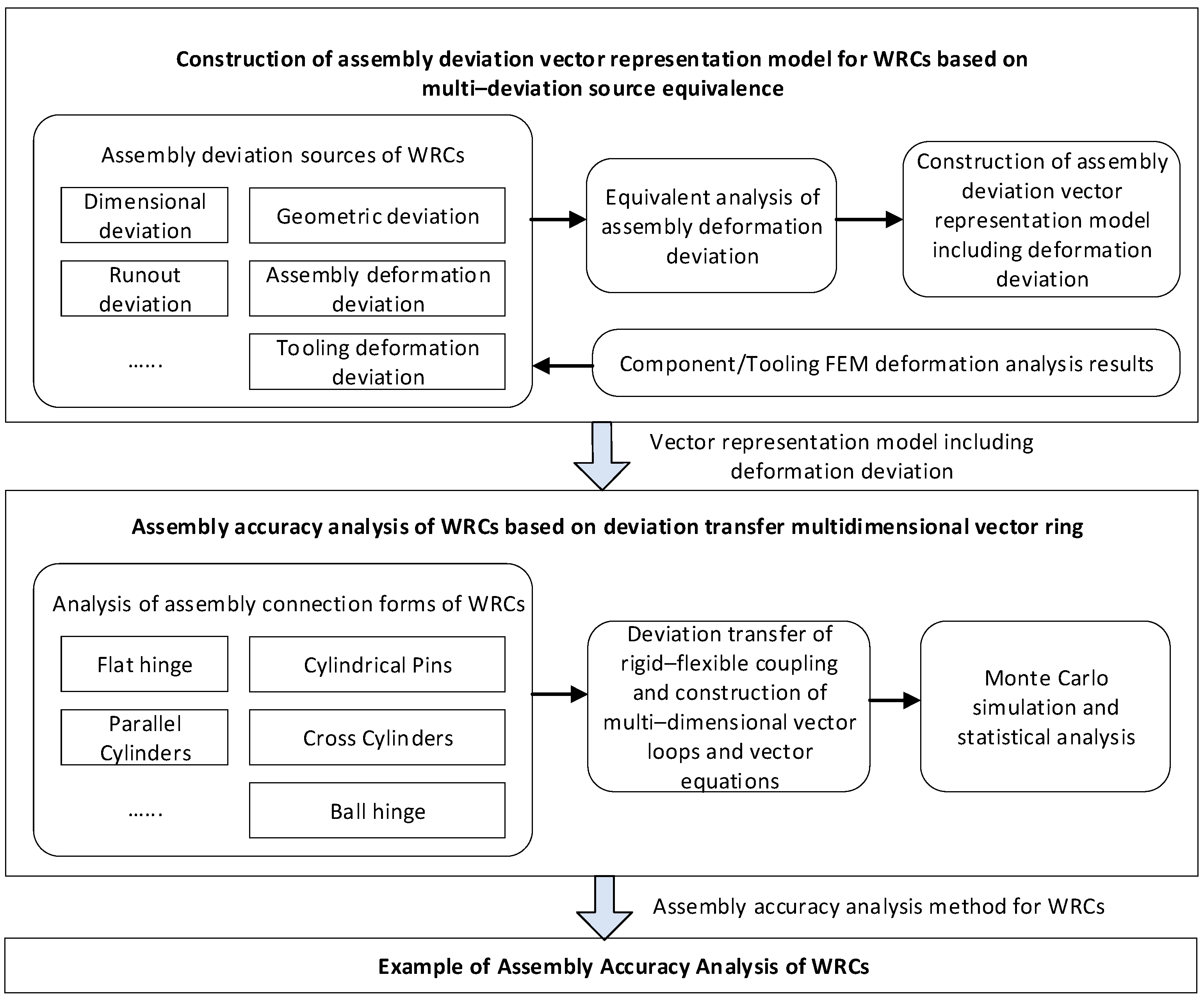

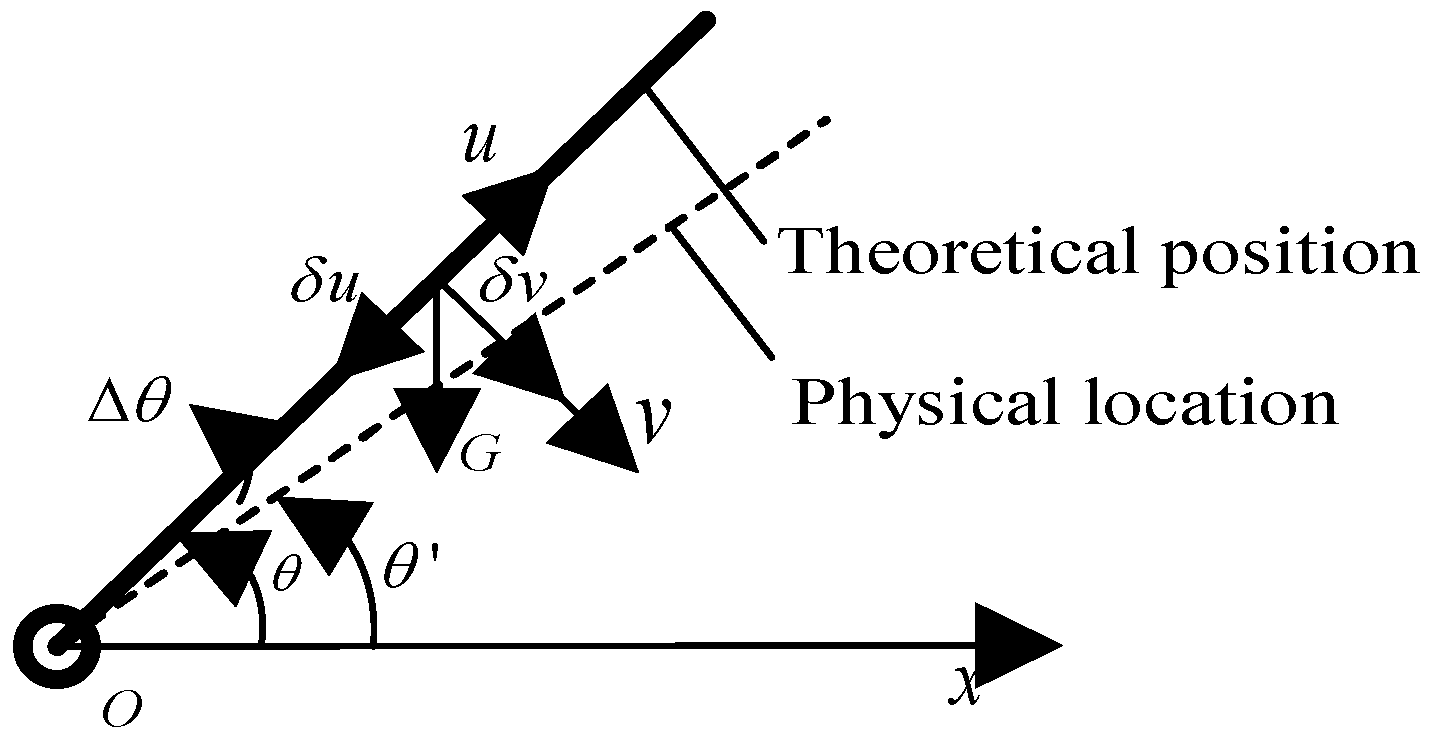


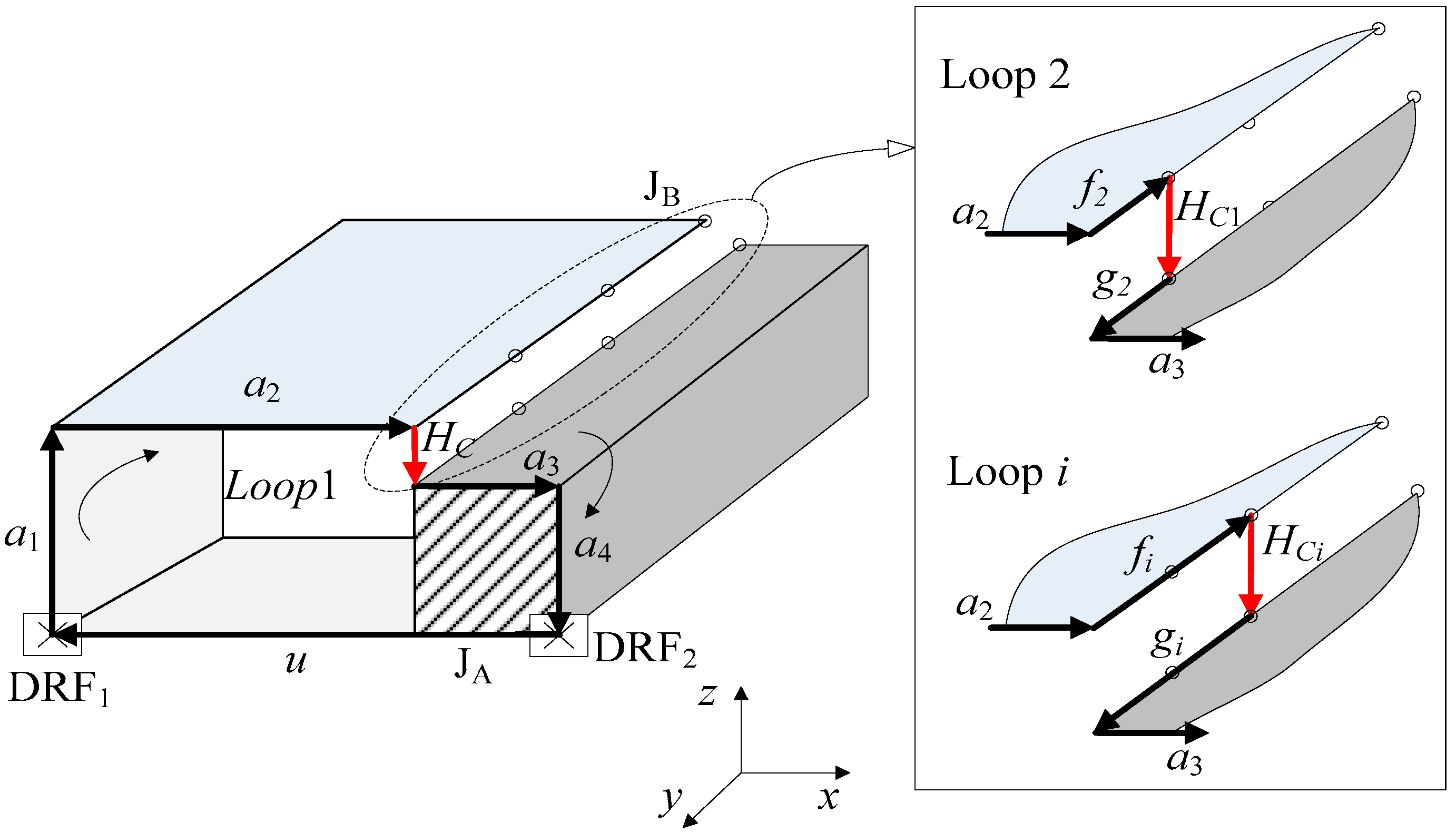

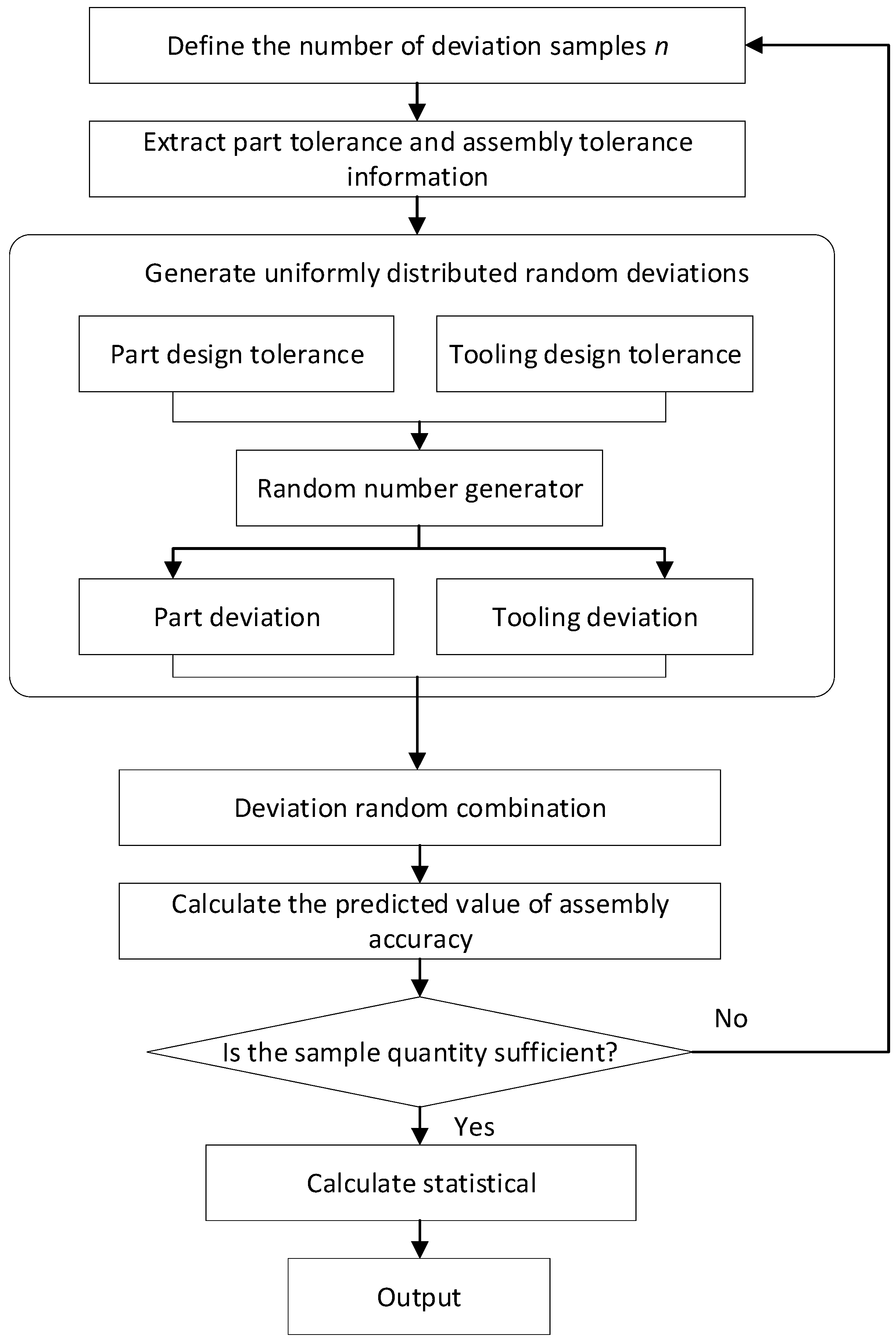
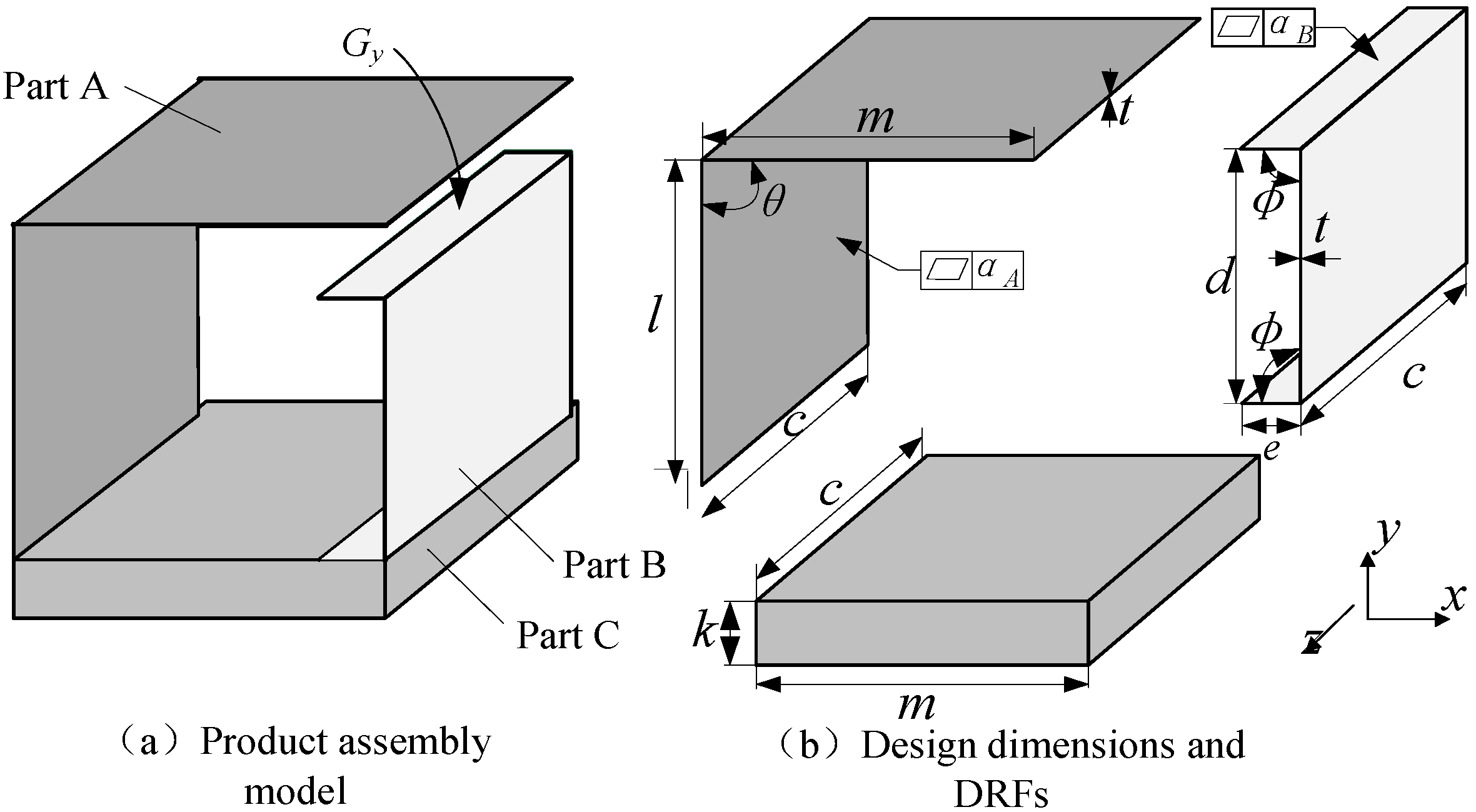
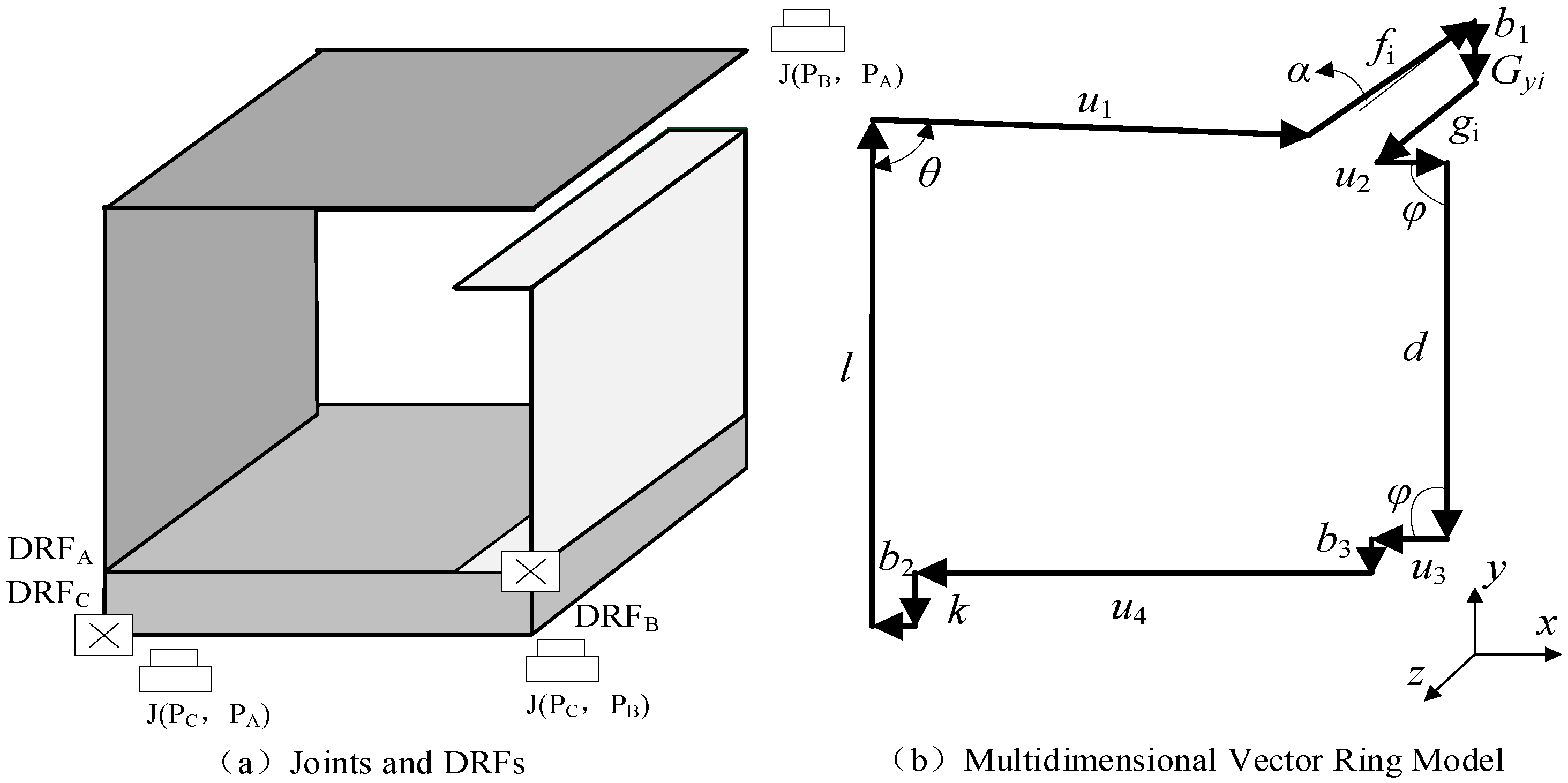
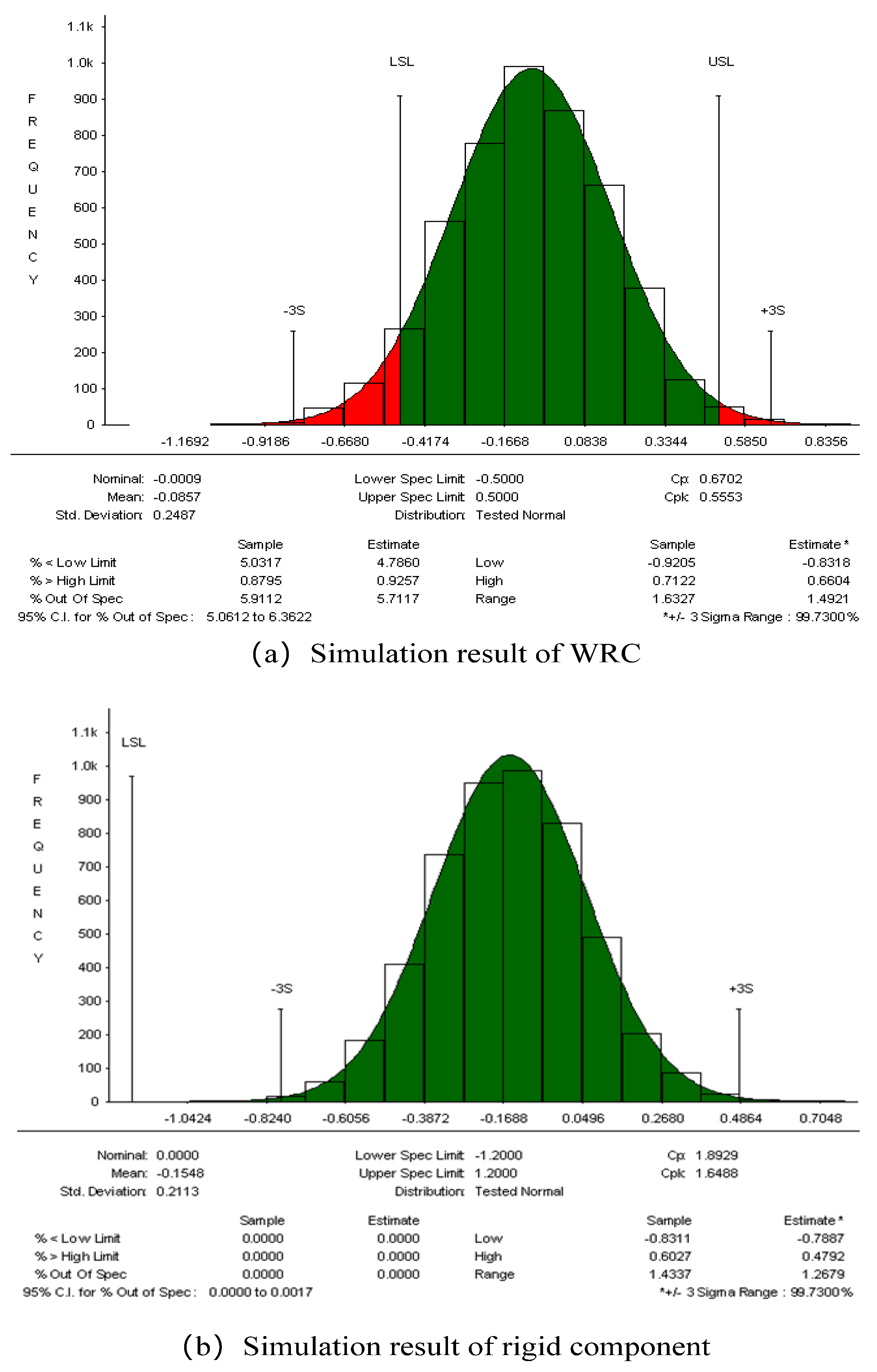
| Dimension Type | Design Dimensions | |||||||||||
|---|---|---|---|---|---|---|---|---|---|---|---|---|
| Dimension parameters | l | c | t | θ | αA | α | d | e | φ | αB | m | k |
| Nominal value/mm | 250 | 350 | 2 | 90 | 0 | 3 | 225 | 38 | 90 | 0 | 250 | 25 |
| Deviation value/±mm | 1 | 1 | 0.2 | 5 * | 0.15 * | 1 * | 1 | 0.2 | 5 | 0.25 * | 1 | 0.2 |
| Dimension Type | Assembling Dimensions | |||||||||||
| Dimension parameters | u1 | u2 | u3 | u4 | fi | gi | ** f1 | ** f2 | ** f3 | ** g1 | ** g2 | ** g3 |
| Nominal value/mm | 225 | 25 | 25 | 225 | ** | ** | 25 | 100 | 250 | 25 | 100 | 250 |
| Deviation value/±mm | 1 | 0.2 | 0.2 | 1 | ** | ** | 0.2 | 0.8 | 1 | 0.2 | 0.8 | 1 |
| Control Object | Design Tolerance/±mm | Simulation Results | ||
|---|---|---|---|---|
| Accuracy Analysis Method for Rigid Components | Accuracy Analysis Method for WRC | |||
| Gyi | Assembly accuracy/mm | 0.5 | 0.211 | 0.248 |
| Qualification rate/% | 100 | 94.09 | ||
Disclaimer/Publisher’s Note: The statements, opinions and data contained in all publications are solely those of the individual author(s) and contributor(s) and not of MDPI and/or the editor(s). MDPI and/or the editor(s) disclaim responsibility for any injury to people or property resulting from any ideas, methods, instructions or products referred to in the content. |
© 2025 by the authors. Licensee MDPI, Basel, Switzerland. This article is an open access article distributed under the terms and conditions of the Creative Commons Attribution (CC BY) license (https://creativecommons.org/licenses/by/4.0/).
Share and Cite
Zhao, D.; Yuan, Z.; Zhao, X.; Wang, G. An Assembly Accuracy Analysis Method for Weak Rigid Components. Machines 2025, 13, 694. https://doi.org/10.3390/machines13080694
Zhao D, Yuan Z, Zhao X, Wang G. An Assembly Accuracy Analysis Method for Weak Rigid Components. Machines. 2025; 13(8):694. https://doi.org/10.3390/machines13080694
Chicago/Turabian StyleZhao, Dongping, Zhe Yuan, Xiaosong Zhao, and Gangfeng Wang. 2025. "An Assembly Accuracy Analysis Method for Weak Rigid Components" Machines 13, no. 8: 694. https://doi.org/10.3390/machines13080694
APA StyleZhao, D., Yuan, Z., Zhao, X., & Wang, G. (2025). An Assembly Accuracy Analysis Method for Weak Rigid Components. Machines, 13(8), 694. https://doi.org/10.3390/machines13080694






